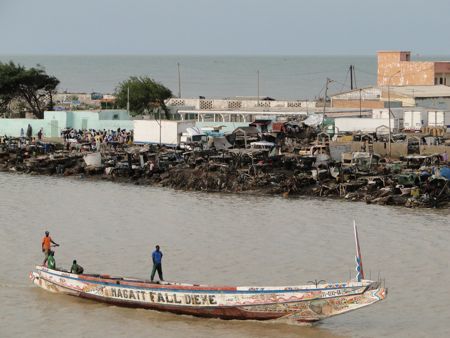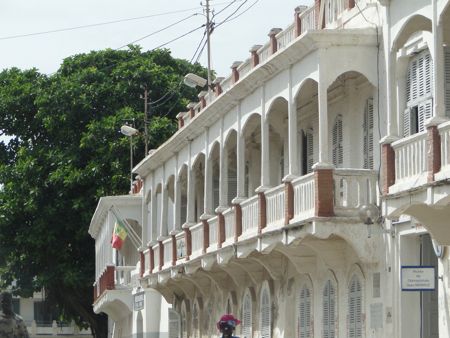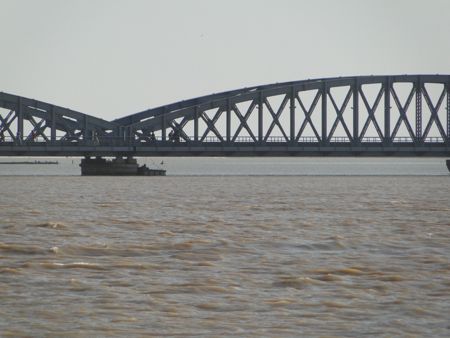Colorful Saint Louis, Senegal

Saint Louis, former capital of French West Africa, boasts a splendor still evident in the old buildings, the 19th century French colonial architecture of long eaves, gabled verandas, and tiled roofs; the stuccoed buildings' color remain the paint box of the tropics. And the music and art remain. Run down but likable, its charm is unmistakable, an island nestled between the shores of the broad, chocolaty Saint Louis River, and a fitting melange of cultures, aesthetics, and traditions.
If Saint Louis in northern Senegal spoke Spanish, it would be Cuba: such is its charm. The majority of the project that led me to Senegal is outside of the Saint Louis region of Senegal's north, and so I've had lots of opportunities to visit the old French capital of West Africa.
To my eyes, Saint Louis' decrepit charm is in the midst of an intense
struggle against the elements and against time. Its splendor is still evident in
the old buildings, the 19th century French colonial architecture of long eaves,
gabled verandas, and tiled roofs; the stuccoed buildings' color remain the
paint box of the tropics. And the music and art remain. Saint Louis sponsors a jazz festival once a year (you make
your reservations a year earlier; that's how popular it is) that brings in
performers from – and makes headlines – around the world. It is a
UNESCO heritage site, and increasingly the beneficiary of millions of dollars of
French investment intended to preserve the cultural heritage and the historical
relevance of this old city. Throughout town, old buildings are being renovated,
repainted, returned to their old splendor.

But time and the elements have not been kind to Saint Louis, and the decades of neglect make the city's return to cultural prominence anything but automatic. Life is hard and resources are scarce, and you've no sooner renovated one building than the roof on another gives way. Clearly the trend is in the direction of increased entropy: structures fall, colors fade, things disperse.
It's still a neat place, whatever its condition. In Dakar the pirogues
(traditional wooden fishing boats in the shape of canoes) measure about 20 feet
in length. In Saint Louis, the pirogues moored at the river's edge are
ocean-going and measure up to 80 feet in length. They are massive wooden things,
with gunwales ten feet over the water line and tested against the open waters of
the South Atlantic. They're impressive. The city itself is an island nestled
between the shores of the broad, chocolaty Saint Louis River (you can imagine
the joy of 16th century Parisian explorers happy to make their colonial home on
the African equivalent of the Île de Notre Dame, with the river
on both sides. The bridge that leads to the island is a low bridge on concrete
piers, and multiple arches of steel girder. It was designed and built by French
architect Eric Eiffel (who also built a tower you may have heard of). A center
span pivots horizontally on immense, steel gears, revealing a passage that
permits the river barges through. A hundred miles upstream lies the old, French
military fortress of Podor (and the site of one of my projects).

Across the way, the last bit of soil separating the river from the Atlantic is the needle-like "Langue de la Barbarie" mostly sandy and home to a couple of small guest houses and a foul fishing station knee-deep in fish guts, rotting produce, and river muck. It's gorgeous as seen from the island, with the evening sun setting in the west, drawing the Casuarina trees into shadow. Close up, the inevitable result of human habitation becomes clear.
It's no surprise this place is so interesting to foreign tourists. In a way, it better results the colonial experience than anywhere I've ever experienced, and remains through the present a testament to the mixing of cultures, aesthetics, and tastes.
Trackbacks
The author does not allow comments to this entry

Comments
Display comments as Linear | Threaded